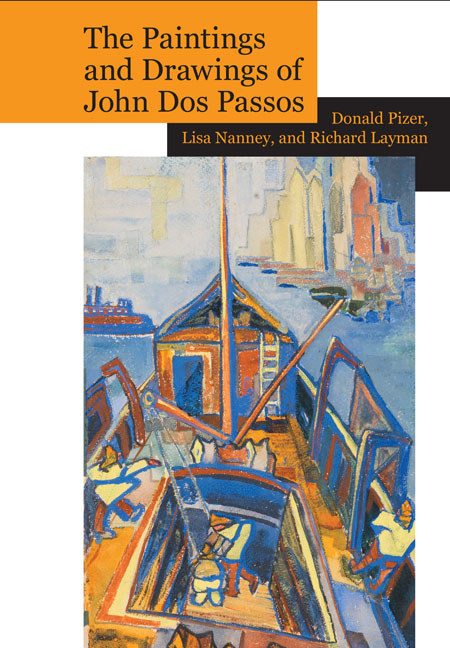Book contents
- Frontmatter
- Contents
- Preface
- Acknowledgments
- The Paintings and Drawings of John Dos Passos: A Collection and Study
- Introduction
- Paintings and Drawings Included in this Volume: A Descriptive List
- Preface to Section 1: Early Work 1918–20
- Preface to Section 2: The Middle East and Morocco 1921–22, 1926
- Preface to Section 3: Paris 1921–25
- Preface to Section 4: New York 1920–24
- Preface to Section 5: New York: Nudes 1920–23
- Preface to Section 6: Theater Designs 1925–28
- Preface to Section 7: Mexico 1926–32
- Preface to Section 8: Later Work 1930–70
- Preface to Section 9: Portraits
- Preface to Section 10: Sea Fronts and Harbors
- Preface to Section 11: Still Lifes
- Preface to Section 12: Studies in Motion
- Preface to Section 13: Abstractions and Other Experimental Modes
- Words and Images: The Visual Art of John Dos Passos
- The Artwork of John Dos Passos
- Notes
- Works Cited
- Index
- Plate section
Preface to Section 8: Later Work 1930–70
from The Paintings and Drawings of John Dos Passos: A Collection and Study
- Frontmatter
- Contents
- Preface
- Acknowledgments
- The Paintings and Drawings of John Dos Passos: A Collection and Study
- Introduction
- Paintings and Drawings Included in this Volume: A Descriptive List
- Preface to Section 1: Early Work 1918–20
- Preface to Section 2: The Middle East and Morocco 1921–22, 1926
- Preface to Section 3: Paris 1921–25
- Preface to Section 4: New York 1920–24
- Preface to Section 5: New York: Nudes 1920–23
- Preface to Section 6: Theater Designs 1925–28
- Preface to Section 7: Mexico 1926–32
- Preface to Section 8: Later Work 1930–70
- Preface to Section 9: Portraits
- Preface to Section 10: Sea Fronts and Harbors
- Preface to Section 11: Still Lifes
- Preface to Section 12: Studies in Motion
- Preface to Section 13: Abstractions and Other Experimental Modes
- Words and Images: The Visual Art of John Dos Passos
- The Artwork of John Dos Passos
- Notes
- Works Cited
- Index
- Plate section
Summary
Much of Dos Passos's art work during the almost four decades from the early 1930s until his death in 1970 stemmed from his continuing penchant for travel. He was especially attracted during these journeys by the possibilities offered for art by paroramic scenes and by extraordinary natural manifestations— or, put another way, by the visually striking in his immediate experience rather than the more placid and every day.
Dos Passos's willingness to explore a natural scene for its dynamic center is well illustrated by figures 43, Madeira; 44, Papua, New Guinea; and 45, Cypress Gardens, Florida. The rocky inlets of figure 43 seem to cascade down the painting; each is separately defined but also plays a role in the disturbing theme of an almost aggressive hostility present in the natural world. Dos Passos's inclination during this last phase of his artistic career toward recasting a natural scene into a statement about nature as whole is also reflected in figure 44. Every natural phenomenon in the painting receives heightened representation: the bulbous clouds pour masses of rain down upon a tortuously winding river and over-luxuriant hillsides while sharp mountain tops penetrate clouds in the distance. In depicting a Florida cypress swamp in figure 45 (one of several on the same subject), Dos Passos ignores the upper portions of the standing trees for the eerie effect created by each tree's ghostly shadow creating an echo of its presence. Nature in these later works is not only melodramatically present but is also revealing some fundamental aspect of its makeup. [DP]
- Type
- Chapter
- Information
- Publisher: Liverpool University PressPrint publication year: 2016



